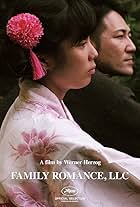LunarPoise
Joined Oct 2004
Welcome to the new profile
We're still working on updating some profile features. To see the badges, ratings breakdowns, and polls for this profile, please go to the previous version.
Ratings405
LunarPoise's rating
Reviews403
LunarPoise's rating
Tatsuya Mori's work on the documentaries A and A2 is outstanding, and created a high level of anticipation for this film. The 1923 massacre of ethnic Koreans is under-represented in social discourse, and Mori's documentaries display suitable sensibilities for this project. Framing the story within the killing of Japanese mistaken for Koreans also seems an astute choice in order to give this project as wide an appeal as possible.
It is a shame, then, that the storytelling so greatly disappoints. Having the action take place over several locations is ambitious, but not all of the threads cohere. The ferryboat man and the wandering minstrels from Kagawa are engaging, but the domestic melodramas seem ill-conceived in this narrative. Most egregiously, the travails of a female journalist in a patriarchal press room lead to much speechifying and pontification. Mai Kiryu gives her all to the part, but the character is little more than a walking manifesto.
There is an abundance of acting talent to enjoy. Hakase Suidôbashi does well as a menacing (and ultimately dangerous) buffoon. Masahiro Higashide oozes charisma, and Eita Nagayama is equally magnetic. But no performance is allowed to come to the fore as the focus meanders through the various love betrayals and family reprisals that bloat the running time to 137 minutes. The killing, when it happens, is quite shocking, but the build up to this emotional climax is mishandled.
It is a story worthy of cinematic telling, and it is welcome testimony to an event Japan still fails to squarely face. However, the bottom line is that the power of this story is under-realized in this outing.
It is a shame, then, that the storytelling so greatly disappoints. Having the action take place over several locations is ambitious, but not all of the threads cohere. The ferryboat man and the wandering minstrels from Kagawa are engaging, but the domestic melodramas seem ill-conceived in this narrative. Most egregiously, the travails of a female journalist in a patriarchal press room lead to much speechifying and pontification. Mai Kiryu gives her all to the part, but the character is little more than a walking manifesto.
There is an abundance of acting talent to enjoy. Hakase Suidôbashi does well as a menacing (and ultimately dangerous) buffoon. Masahiro Higashide oozes charisma, and Eita Nagayama is equally magnetic. But no performance is allowed to come to the fore as the focus meanders through the various love betrayals and family reprisals that bloat the running time to 137 minutes. The killing, when it happens, is quite shocking, but the build up to this emotional climax is mishandled.
It is a story worthy of cinematic telling, and it is welcome testimony to an event Japan still fails to squarely face. However, the bottom line is that the power of this story is under-realized in this outing.
Death Proof is a homage to 70s movies. It contains a treasure trove of explicit and hidden references to the pop culture of the director's childhood. It is an exercise in stylistic excess. What it is not, however, is entertaining and engaging.
The lighting is intentionally poor, and the colors are washed out. The actors overact egregiously. The added visual effect of a worn-out film print adds nothing to the viewers' aesthetic pleasure. The trash talk of the women not only sounds like men, it sounds like one man in particular. Like a lot of Tarantino characters post Pulp Fiction, there is no differentiation in characterization through dialogue. These tedious longueurs are simply infantile; pure cringe.
The action sequence with two cars at the end is entertaining, but the wait to get there is interminable. In sum, ill-advised from conception, Death Proof is dull, pointless and self-indulgent.
The lighting is intentionally poor, and the colors are washed out. The actors overact egregiously. The added visual effect of a worn-out film print adds nothing to the viewers' aesthetic pleasure. The trash talk of the women not only sounds like men, it sounds like one man in particular. Like a lot of Tarantino characters post Pulp Fiction, there is no differentiation in characterization through dialogue. These tedious longueurs are simply infantile; pure cringe.
The action sequence with two cars at the end is entertaining, but the wait to get there is interminable. In sum, ill-advised from conception, Death Proof is dull, pointless and self-indulgent.
























